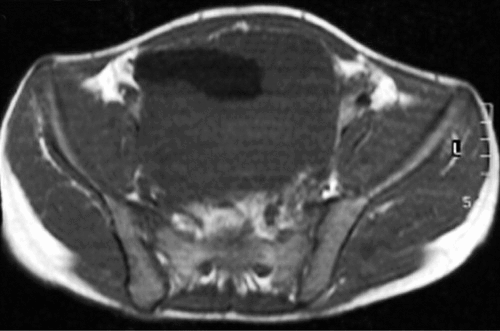Neurofibroma MRI: Difference between revisions
Jump to navigation
Jump to search
Sara Mohsin (talk | contribs) (→MRI) |
No edit summary |
||
| Line 13: | Line 13: | ||
! style="background:#4479BA; color: #FFFFFF;" align="center" + |Characteristics | ! style="background:#4479BA; color: #FFFFFF;" align="center" + |Characteristics | ||
|- | |- | ||
|style="background:#DCDCDC;" align="center" + |'''T1''' | | style="background:#DCDCDC;" align="center" + |'''T1''' | ||
| | | | ||
* Hypointense | * Hypointense | ||
| Line 19: | Line 19: | ||
* Center demonstrating a higher signal intensity than the periphery (reverse of target sign on T2) | * Center demonstrating a higher signal intensity than the periphery (reverse of target sign on T2) | ||
|- | |- | ||
|style="background:#DCDCDC;" align="center" + |'''T2''' | | style="background:#DCDCDC;" align="center" + |'''T2''' | ||
| | | | ||
* Hyperintense | * Hyperintense | ||
| Line 26: | Line 26: | ||
** Low signal intensity centrally with a ring of high signal intensity peripherally | ** Low signal intensity centrally with a ring of high signal intensity peripherally | ||
** Due to a dense central area of collagenous stroma | ** Due to a dense central area of collagenous stroma | ||
** Highly suggestive of neurofibroma but occasionally also seen in schwannomas and malignant peripheral nerve sheath tumors | ** Highly suggestive of neurofibroma but occasionally also seen in [[schwannomas]] and malignant peripheral nerve sheath tumors | ||
* Fascicular sign | * Fascicular sign | ||
* Plexiform neurofibromas may appear as a larger and more infiltrating mass with lobulated borders with inhomogeneous enhancement | * Plexiform neurofibromas may appear as a larger and more infiltrating mass with lobulated borders with inhomogeneous enhancement | ||
* Myxoid stroma enhancement helps differentiating the high signal intensity at T2-weighted imaging from cystic change or necrosis | * Myxoid stroma enhancement helps differentiating the high signal intensity at T2-weighted imaging from cystic change or necrosis | ||
|- | |- | ||
|style="background:#DCDCDC;" align="center" + |'''T1 C+ (Gd) (with gadolinium contrast)''' | | style="background:#DCDCDC;" align="center" + |'''T1 C+ (Gd) (with gadolinium contrast)''' | ||
| | | | ||
* Heterogenous enhancement | * Heterogenous enhancement | ||
|} | |} | ||
[[File:Mri submand gif.gif|thumb|300px|none|Plexiform neurofibroma of the submandibular gland in patient with von Recklinghausen's disease. The MRI T-2 weighted image with contrast (A. Axial & B. Coronal view) showed a mass with diffuse heterogeneous enhancement in the left submandibular gland. [https://openi.nlm.nih.gov/detailedresult?img=PMC3070454_rt-2011-1-e4-g003&query=&req=4 Source: Bisher HA. et al, General Surgery Department, King Fahd Hospital of the University, Al Khobar, Saudi Arabia]]] | |||
{| | {| | ||
| | | | ||
| Line 44: | Line 45: | ||
[[File:Enhanced gd gif.gif|thumb|300px|none|Plexiform Neurofibroma of the Bladder.Axial gadolinium-enhanced MR image shows mild nonuniform enhancement of the large bladder mass. Source: Wilkinson LM. et al, From the Department of Medical Imaging, Hospital for Sick Children, Toronto, Ontario, Canada.]]] | [[File:Enhanced gd gif.gif|thumb|300px|none|Plexiform Neurofibroma of the Bladder.Axial gadolinium-enhanced MR image shows mild nonuniform enhancement of the large bladder mass. Source: Wilkinson LM. et al, From the Department of Medical Imaging, Hospital for Sick Children, Toronto, Ontario, Canada.]]] | ||
|- | |- | ||
|} | |} | ||
Revision as of 20:26, 17 April 2019
|
Neurofibroma Microchapters |
|
Diagnosis |
|---|
|
Treatment |
|
Case Studies |
|
Neurofibroma MRI On the Web |
|
American Roentgen Ray Society Images of Neurofibroma MRI |
Editor-In-Chief: C. Michael Gibson, M.S., M.D. [1]; Associate Editor(s)-in-Chief: Sara Mohsin, M.D.[2] Shanshan Cen, M.D. [3]
Overview
MRI may be helpful in the diagnosis of neurofibroma.
MRI
| MRI sequence | Characteristics |
|---|---|
| T1 |
|
| T2 |
|
| T1 C+ (Gd) (with gadolinium contrast) |
|

 |
 |
 |
References
- ↑ Neurofibroma.Dr Bruno Di Muzio and Dr Maxime St-Amant et al. Radiopaedia.org 2015. http://radiopaedia.org/articles/neurofibroma Accessed on November 17, 2015
- ↑ https://pubs.rsna.org/doi/10.1148/rg.24si035170#REF8